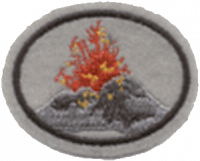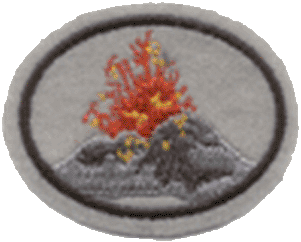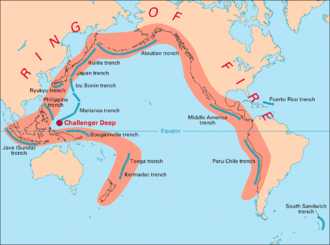Difference between revisions of "AY Honors/Volcanoes/Answer Key/es"
(Created page with "</noinclude> ==Referencias== {{:Adventist Youth Honors Answer Book/Regional/flpatchnote/es}} Category:Adventist Youth Honors Answer Book/noindex/es <section end="Body" />...") |
(Created page with "</noinclude> <!-- 3. Identificar y marcar las siguientes partes de un volcán en una hoja de trabajo o en su propio dibujo: -->") |
||
| Line 42: | Line 42: | ||
{{CloseReq}} <!-- 2 --> | {{CloseReq}} <!-- 2 --> | ||
{{ansreq|page={{#titleparts:{{PAGENAME}}|2|1}}|num=3}} | {{ansreq|page={{#titleparts:{{PAGENAME}}|2|1}}|num=3}} | ||
| − | <noinclude> | + | <noinclude></noinclude> |
| − | </noinclude> | + | <!-- 3. Identificar y marcar las siguientes partes de un volcán en una hoja de trabajo o en su propio dibujo: --> |
| − | <!-- 3. | ||
| − | |||
| − | |||
| − | |||
| − | |||
| − | |||
| − | |||
| − | |||
| − | |||
| − | |||
<noinclude></noinclude> | <noinclude></noinclude> | ||
| Line 91: | Line 81: | ||
{{CloseReq}} <!-- 3 --> | {{CloseReq}} <!-- 3 --> | ||
{{ansreq|page={{#titleparts:{{PAGENAME}}|2|1}}|num=4}} | {{ansreq|page={{#titleparts:{{PAGENAME}}|2|1}}|num=4}} | ||
| − | <noinclude> | + | <noinclude></noinclude> |
| − | </noinclude> | + | <!-- 4. Describir las diferentes clases de lava y dibujar una imagen para cada una: --> |
| − | <!-- 4. | + | <noinclude></noinclude> |
| − | <noinclude | ||
| − | |||
{{ansreq|page={{#titleparts:{{PAGENAME}}|2|1}}|num=4a}} | {{ansreq|page={{#titleparts:{{PAGENAME}}|2|1}}|num=4a}} | ||
<noinclude></noinclude> | <noinclude></noinclude> | ||
| Line 130: | Line 118: | ||
{{CloseReq}} <!-- 4 --> | {{CloseReq}} <!-- 4 --> | ||
{{ansreq|page={{#titleparts:{{PAGENAME}}|2|1}}|num=5}} | {{ansreq|page={{#titleparts:{{PAGENAME}}|2|1}}|num=5}} | ||
| − | <noinclude> | + | <noinclude></noinclude> |
| − | </noinclude> | + | <!-- 5. Definir los siguientes términos: --> |
| − | <!-- 5. | + | <noinclude></noinclude> |
| − | <noinclude | ||
| − | |||
{{ansreq|page={{#titleparts:{{PAGENAME}}|2|1}}|num=5a}} | {{ansreq|page={{#titleparts:{{PAGENAME}}|2|1}}|num=5a}} | ||
<noinclude></noinclude> | <noinclude></noinclude> | ||
| Line 193: | Line 179: | ||
{{CloseReq}} <!-- 5 --> | {{CloseReq}} <!-- 5 --> | ||
{{ansreq|page={{#titleparts:{{PAGENAME}}|2|1}}|num=6}} | {{ansreq|page={{#titleparts:{{PAGENAME}}|2|1}}|num=6}} | ||
| − | <noinclude> | + | <noinclude></noinclude> |
| − | </noinclude> | + | <!-- 6. Explicar cómo un volcán entra en erupción. --> |
| − | <!-- 6. | ||
| − | |||
| − | |||
| − | |||
<noinclude></noinclude> | <noinclude></noinclude> | ||
{{CloseReq}} <!-- 6 --> | {{CloseReq}} <!-- 6 --> | ||
{{ansreq|page={{#titleparts:{{PAGENAME}}|2|1}}|num=7}} | {{ansreq|page={{#titleparts:{{PAGENAME}}|2|1}}|num=7}} | ||
| − | <noinclude> | + | <noinclude></noinclude> |
| − | </noinclude> | + | <!-- 7. Definir los cuatro niveles de actividad de los volcanes: --> |
| − | <!-- 7. | ||
| − | |||
| − | |||
<noinclude></noinclude> | <noinclude></noinclude> | ||
| Line 260: | Line 239: | ||
</div> | </div> | ||
| − | + | {{clear}} | |
| − | |||
| − | |||
{{clear}} | {{clear}} | ||
| − | + | {{clear}} | |
| − | |||
| − | |||
<div lang="en" dir="ltr" class="mw-content-ltr"> | <div lang="en" dir="ltr" class="mw-content-ltr"> | ||
| Line 282: | Line 257: | ||
</div> | </div> | ||
| − | + | <noinclude></noinclude> | |
| − | <noinclude | ||
| − | |||
{{CloseReq}} <!-- 10 --> | {{CloseReq}} <!-- 10 --> | ||
{{ansreq|page={{#titleparts:{{PAGENAME}}|2|1}}|num=11}} | {{ansreq|page={{#titleparts:{{PAGENAME}}|2|1}}|num=11}} | ||
| Line 300: | Line 273: | ||
</div> | </div> | ||
| − | + | {{clear}} | |
| − | {{ | ||
| − | |||
| − | |||
| − | |||
| − | |||
| − | |||
| − | }} | ||
| − | |||
| − | + | {{clear}} | |
| − | {{ | ||
| − | |||
| − | |||
| − | |||
| − | |||
| − | |||
| − | |||
| − | |||
| − | |||
| − | }} | ||
| − | |||
<noinclude></noinclude> | <noinclude></noinclude> | ||
Revision as of 22:46, 16 May 2021
1
2
2a
2b
2c
2d
2e
3
3a
3b
3c
3d
3e
3f
3g
3h
4
4a
4b
4c
4d
5
5a
i
ii
iii
iv
5b
5c
5d
5e
5f
6
7
7a
7b
7c
7d
8
- http://en.wikipedia.org/wiki/Pacific_ring_of_fire
- Of the more than 800 active volcanoes that have been identified, most are located along the margins of the ocean basins—most notably along the within the circum-Pacific belt known as the Ring of Fire. This active zone includes a chain of continental volcanoes that consist primarily of composite volcanoes.
- The Pacific Ring of Fire is an area of frequent earthquakes and volcanic eruptions encircling the basin of the Pacific Ocean. In a 40,000 km horseshoe shape, it is associated with a nearly continuous series of oceanic trenches, island arcs, and volcanic mountain ranges and/or plate movements. It is sometimes called the circum-Pacific belt or the circum-Pacific seismic belt. 90% of the world's earthquakes and 81% of the world's largest earthquakes occur along the Ring of Fire.
9
- The Hawaiian Islands result from the movement of the Pacific plate over an apparently stationary hot spot. The island of Hawaii is still forming from the uplifting of mantel plumes under the hot spot. The island of Hawaii is the youngest of the Hawaiian islands, and the island of Kauai is the oldest of the large islands in the Hawaiian chain.
10
- Mount St. Helens is located in southwestern Washington State, about 50 miles northeast of Portland, Oregon. It is in the Cascade Range of mountain. It was named in 1792 in honor of the Baron St. Helens. American Indians of the Pacific Northwest called it "Louwala-Clough" or "smoking mountain." The volcano was active in the mid-1800s, but most people in this century did not see it as a menace. In fact, the mountain was snow-covered and very beautiful. The forest on it and around the base was filled with wildlife. At the base of the volcano was Spirit Lake, a clear mountain lake that was very good for fishing and boating.
Other interesting Volcanoes
Other interesting volcanoes include:
- Mount Pinatubo eruption of 1991 (Philippines)
- Krakatoa eruption of 1883 (Indonesia)
- Vesuvius eruption of 79 A.D. (Italy)
- Mount Etna eruption of 1669 (Italy)
- Popocatépetl eruption of 1994 (Mexico)
- Tambora eruption of 1815 (Indonesia, most powerful eruption in recorded history)
- Taupo eruption of 181 A.D. (New Zealand, most powerful eruption in the past 5000 years).
11
(Using some imagination)
The glory of GOD—let it last forever! Let GOD enjoy his creation! He takes one look at earth and triggers an earthquake, points a finger at the mountains, and volcanoes erupt.
12
There are a number of ways to approach this requirement. A very easy way to meet it is to download this PDF which is a 3D model that can be printed, cut out, and glued together.
You can also build a model volcano using the tube from a roll of paper towels or toilet paper, some newspaper, a cardboard base, and some papier-mâché.
Referencias
Adventist Youth Honors Answer Book/Regional/flpatchnote/es




